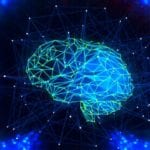 Politics
Politics  Politics
Politics  Weird Stuff
Weird Stuff Ten Bizarre Facts About The Doge Meme
 Our World
Our World 10 Ways Your Christmas Tree Is More Lit Than You Think
 Movies and TV
Movies and TV The 10 Coolest Stars to Set Sail on The Love Boat
 History
History 10 Things You Didn’t Know About the American National Anthem
 Technology
Technology Top 10 Everyday Tech Buzzwords That Hide a Darker Past
 Humans
Humans 10 Everyday Human Behaviors That Are Actually Survival Instincts
 Animals
Animals 10 Animals That Humiliated and Harmed Historical Leaders
 History
History 10 Most Influential Protests in Modern History
 Creepy
Creepy 10 More Representations of Death from Myth, Legend, and Folktale
 Politics
Politics 10 Political Scandals That Sent Crowds Into the Streets
 Weird Stuff
Weird Stuff Ten Bizarre Facts About The Doge Meme
 Our World
Our World 10 Ways Your Christmas Tree Is More Lit Than You Think
Who's Behind Listverse?

Jamie Frater
Head Editor
Jamie founded Listverse due to an insatiable desire to share fascinating, obscure, and bizarre facts. He has been a guest speaker on numerous national radio and television stations and is a five time published author.
More About Us Movies and TV
Movies and TV The 10 Coolest Stars to Set Sail on The Love Boat
 History
History 10 Things You Didn’t Know About the American National Anthem
 Technology
Technology Top 10 Everyday Tech Buzzwords That Hide a Darker Past
 Humans
Humans 10 Everyday Human Behaviors That Are Actually Survival Instincts
 Animals
Animals 10 Animals That Humiliated and Harmed Historical Leaders
 History
History 10 Most Influential Protests in Modern History
 Creepy
Creepy 10 More Representations of Death from Myth, Legend, and Folktale
8 Scientific Advances That May Change The Future
In a year when science has become both our saving grace against a global pandemic and a target of political pundits, it might be a good time to look back at all the good that science has done for us these past few years.
Whether making discoveries that can change little aspects of our daily lives or finding cures for diseases that have hounded humanity, scientists have been hard at work trying to push us toward a brighter future.
10 Recent Scientific Breakthroughs And Discoveries
8 mRNA Vaccines

Although most people know that DNA is the genetic material inside our cells, the role of mRNA may be less understood. DNA contains instructions that guide our cells to make the proteins we need. As DNA is so important, the one copy of DNA we have in each cell cannot be damaged.
To prevent any damage from happening, our cells make many copies of the sections of DNA that they need to guide their protein making. These copies are called mRNA copies. If they get damaged, they are just discarded.
With that in mind, scientists have found a way to use mRNA to make a new type of vaccine. Viruses infect human cells by injecting their DNA into the cells and forcing our cellular machinery to make viral proteins using this DNA.
Most vaccines involve taking whole inactivated viruses or pieces of the viruses and injecting them. This teaches our bodies how to make antibodies against the virus.
A new vaccine in clinical testing eliminates the need for viruses in the vaccine. Instead, the new Moderna vaccine aims to tackle the virus causing COVID-19 by injecting us with a small piece of mRNA that teaches our cells how to make a spike protein found on the outside of the virus. When our cells make this protein, our immune system attacks it by producing antibodies, giving us the same type of protection we would get from exposure to the virus.[1]
This method has greatly simplified the vaccine development process, which normally takes over 10 years. It took a little over two months to go from the planning phase to the first clinical trial of Moderna’s vaccine. If all goes well, it may be the vaccine that ends the coronavirus pandemic.
7 Mind-Controlled Prostheses
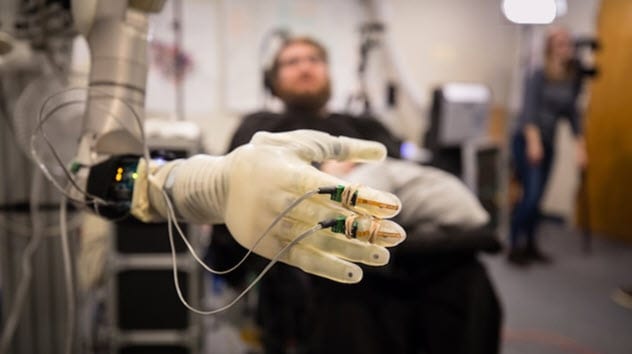
In 2016, a team from the University of Pittsburgh, the University of Pittsburgh Medical Center (UPMC), and the University of Chicago gave one man the gift of a lifetime. Paralyzed after a car accident in 2004, Nathan Copeland lost full use of his body from the chest down. Amazingly, he is now able to both feel and control a prosthetic limb with only his mind.[2]
This huge scientific leap was made possible by implanting electrodes in the areas of Copeland’s brain that control movement and touch sensations. When Copeland thinks about moving his arm, these electrodes interpret the activity from his brain cells to move the robotic arm. When something touches the robotic hand, sensors send electrical signals that stimulate Copeland’s brain to feel the touch.
The National Institutes of Health is providing a combined $7 million to Pitt, UPMC, and Chicago to continue the research.
6 Understanding Autism
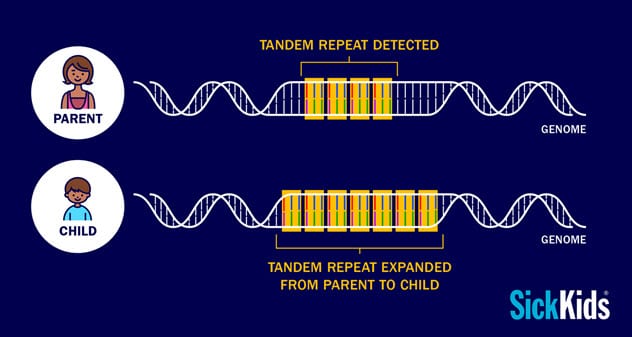
Autism has long been a misunderstood disorder as the cause has been difficult to trace. This has led to an influx of theories, ranging from the scientific approach of suggesting it is a genetic disorder to the Facebook groups and bloggers blaming it on vaccinations. People with autism generally lack social and verbal communication skills or exhibit repetitive behaviors. The extent of the symptoms can vary widely, making it a spectrum disorder.
By analyzing the DNA of autistic children against the DNA from their parents, scientists at the Hospital for Sick Children in Toronto have made an important discovery. There are regions of DNA in the body called tandem repeats. They are a pattern of the DNA sequence that is repeated multiple times.
These Toronto scientists discovered that autistic children often have double or triple the number of tandem repeats that their parents have. The larger these tandem repeats are, the more they impair the function of the gene. In autistic children, tandem repeats have been found in genes related to brain function.[3]
By identifying this strange phenomenon, scientists may now have a new way to diagnose autism. In addition, this provides a clearer understanding of what causes autism, meaning new treatments may be on the horizon. Some scientists also believe that a similar type of tandem repeat expansion may be the cause of epilepsy and disorders like schizophrenia.
5 A Treatment For Alzheimer’s Disease
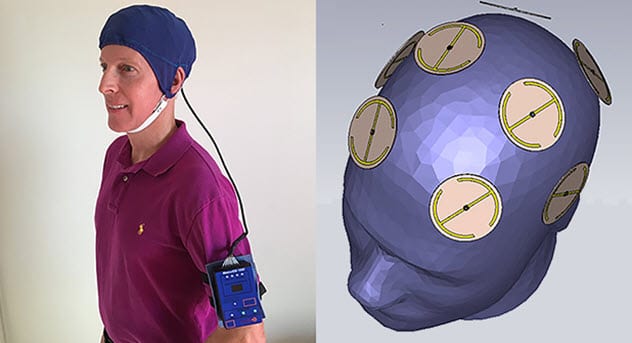
In the brain, the tau protein found in neurons helps to hold their axons together. Neurons are nerve cells, and they send signals across their axons. By sending these signals, we experience sensations like touch.
In people with Alzheimer’s disease, tau proteins are tangled up inside the nerve axons. This prevents signals from traveling down the axons and leads to problems with brain functioning. In addition, the buildup of another protein called beta-amyloid forms clumps between neurons, also limiting neuron functioning.
In 2019, NeuroEM Therapeutics, Inc., tested a wearable cap that sends electromagnetic waves through the brain to break apart the buildup of these proteins. The first clinical study of eight patients found that seven experienced a return of some cognitive function. More extensive studies are underway to try to confirm these results.[4]
Independent laboratories performed similar experiments on mice and found that cognitive function was improved from exposure to electromagnetic waves. Although it is still early days for this treatment, it may provide a ray of hope to those suffering from Alzheimer’s. So far, drug treatments for Alzheimer’s disease have done little but mildly slow down its progression, so finding new approaches to this problem is always exciting.
Top 10 Scientific Breakthroughs Of The Month (March 2019)
4 Universal Flu Vaccines
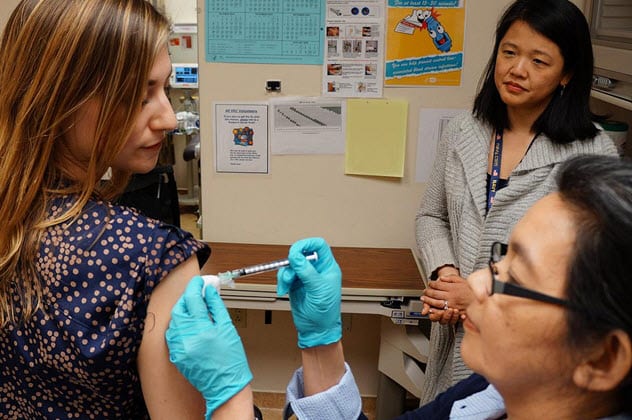
We need to get flu shots every year because flu virus strains change annually. Flu vaccines produce an immune response against the head of a protein on the flu virus. (The protein is called HA).
The problem is that the HA head changes often because it can mutate rapidly. As a result, we need new flu shots every year to provide immunity against the new HA head.[5]
This problem may soon be eliminated. It turns out that the stem of the HA protein, which holds the head, does not change. It is relatively constant among strains of the flu.
A new vaccine created by the scientists of NIAID’s Vaccine Research Center has just entered clinical testing, and it targets this stem instead of the head. If this is successful, a single vaccine would make us immune to most strains of the flu for a much longer time. It will likely be a while before we know the effectiveness of this vaccine. But it is a big step toward finding a universal one-time-only flu shot.
3 The Medusavirus Discovery
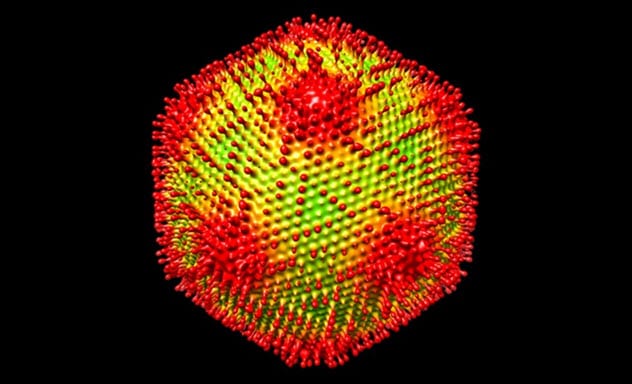
A new virus isolated from a hot spring in Japan has been dubbed the “Medusavirus.” This name comes from the mythical monster Medusa who would turn her victims to stone when they looked into her eyes. In similar fashion, the Medusavirus turns its amoeba hosts into stone by hijacking their cellular machinery.
Luckily, this virus cannot infect humans. But it does have a rather interesting set of proteins called histones. They are used to package DNA in the nuclei of cells. However, viruses do not have nuclei, and the Medusavirus is no exception.
Scientists believe that this may provide insight into how eukaryotic life came to be. Eukaryotes are cells with nuclei, like the ones that make up our bodies. When viruses infect host cells, they tend to leave a mark on the surviving host cell’s DNA. The virus sometimes picks up DNA sequences from the host as well. Basically, the host and virus evolve together.
Thus, figuring out how the Medusavirus obtained these histone proteins could give us insight into how early cells evolved to become the complex modern cells of today.[6]
2 Metal-Eating Microbes
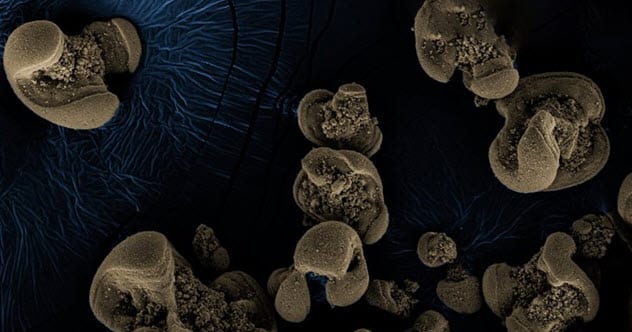
For years, scientists and engineers have wondered why lumps of manganese oxide collect on the seafloor and why this compound seems to build up in water pipes. Caltech scientist Jared Leadbeater finally answered some of these questions when he left glassware containing manganese carbonate to soak in his sink while he was away on a work trip.
When he returned, the normally cream-colored manganese carbonate had turned into black manganese oxide. After replicating the situation in an experiment with both sterilized and unsterilized jars, Leadbeater found that only the unsterilized jars had turned black. This means that some sort of microbe caused the reaction.
After further testing, Leadbeater and his team narrowed the list down to two microbes. They discovered that these bacteria cells could eat the electrons in manganese to make their own energy. This leaves manganese oxide behind.
It is the first time that scientists have found microbes that can use manganese as an energy source. This discovery may help us to understand how manganese, a very common element, helped to shape the evolution of the planet.[7]
1 A Cure For Ebola

Although we are in the midst of a new coronavirus pandemic, it was not too long ago that pandemic fears were focused on Ebola. This viral illness starts off with fevers and the shakes. It can then progress to uncontrolled bleeding and organ failure.
This often-fatal disease has been researched for years. In 2019, a clinical trial identified a new drug therapy that reduced the death rate from 75 percent without treatment to 29 percent with the new therapy. If Ebola is treated very early, the death rate dropped all the way to 6 percent.
This new drug by Regeneron contains a mixture of antibodies, which are made by our immune cells to clear infections from our bodies. These antibodies specially attack the Ebola virus.
It is difficult to make antibodies in a lab as they need to work in the human body without being attacked by the immune system. In addition, the Ebola virus can change shape. This is why a mixture of different antibodies must be used in the treatment. This new therapy is currently being tested and may soon become a lifesaving tool.[8]
Top 10 Scientific Breakthroughs Of The Month (May 2019)


